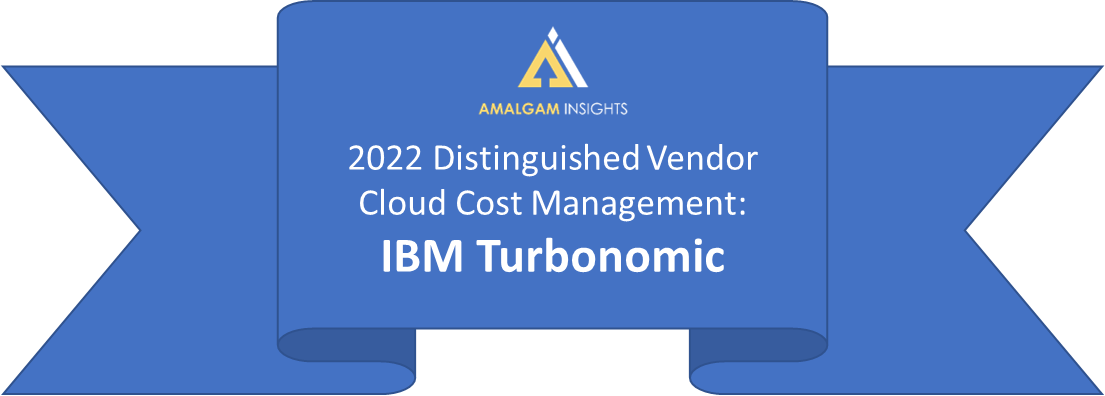
Amalgam Insights continues to present its list of Distinguished Vendors for Cloud Cost and Optimization Management. This matters because analysts assessed nearly 30 providers for this effort; only a third were able to demonstrate genuine differentiators and approaches that satisfied Amalgam Insights’ requirements for achieving Distinguished Vendor status. To that point, we already have posted profiles on SADA, Spot by NetApp, Apptio Cloudability, Yotascale, Kion, and CAST AI . We next discuss IBM Turbonomic.
WHY IBM TURBONOMIC FOR CLOUD COST AND OPTIMIZATION MANAGEMENT
- Focus on application performance, which leads to savings
- Platform configuration is automated, saving IT time and effort during deployment
- Software learns from organizations’ actions, so recommendations improve over time
ABOUT IBM TURBONOMIC
IBM Turbonomic is an Amalgam Insights Distinguished Vendor for Cloud Cost and Optimization Management. Founded in 2009, Turbonomic was acquired by IBM in 2021. IBM Turbonomic now acts as Big Blue’s solution to ensure application performance and governance across cloud environments, including public and private. Turbonomic has two offices in the United States — its headquarters in Boston and a satellite location in Newark, Delaware — as well as one in the UK and another in Canada. IBM does not publicly disclose how many Turbonomic employees it has, nor does it break out Turbonomic annual revenue or provide customer retention rates.
In terms of cloud spend under management, Turbonomic states that it does not track the amount of money its clients spend on cloud computing. Turbonomic serves Fortune 2000 customers across industries including finance, insurance, and healthcare. Turbonomic is typically considered by organizations that have at least 1,000 cloud instances or virtual machines; many support tens of thousands.
IBM TURBONOMIC’S OFFERING
IBM Turbonomic Application Resource Management targets application performance and governance throughout an organization’s cloud environment, which can include public cloud (Amazon Web Services, Microsoft Azure, Google Cloud), private cloud (IBM, VMware), and multi-cloud environments.
The platform optimizes cloud computing, storage, database as a service, reserved instances, and Kubernetes, but does not currently address spot instances). Furthermore, it optimizes and scales based on IOPs (input/output), reservations, and discounts. Overall, IBM Turbonomic aims to ensure spend aligns to applications, preventing cost overruns and keeping applications performing optimally. While Turbonomic mainly serves IT users, Turbonomic recently teamed with Flexera to add a detailed cost-reporting module that appeals to Financial Operations (FinOps) experts.
IBM Turbonomic charges for its cloud application optimization software based on the number of resources under management. Rather than offering individual add-on capabilities, IBM Turbonomic lets clients choose more advanced capabilities by buying different licensing tiers associated with integrations to other software and processes such as IT service management, orchestrators, and application performance management. IBM Turbonomic includes technical support with all tiers. IBM Turbonomic and its third-party channel partners offer professional services as needed.
IBM Turbonomic states that its top differentiator originates from artificial intelligence that matches application demand to underlying infrastructure supply at every layer of the stack continuously in real-time with automatable resourcing decisions. As more organizations use IBM Turbonomic, the automated recommendations provided to all of its customers improve. Cloud administrators gain insight into suggested actions, such as investments to enhance performance and save money.
IBM Turbonomic Application Resource Management is delivered as software-as-a-service. It works across public, private, containerized, and bare metal cloud environments. IBM Turbonomic’s reference customers include Providence Health, which has 120,000 employees; Litehouse Foods, which makes salad dressing, cheese, and other foods; and apparel maker Carhartt.
COMPETITION AND COMPETITIVE POSITIONING
IBM Turbonomic mainly competes against organizations’ in-house spreadsheets and mix of tools that are specific to the technologies in use. In these cases, IBM Turbonomic finds that organizations are over-provisioning cloud computing resources in the hopes of mitigating risk. Therefore, they are spending too much and only addressing application performance when something goes wrong.
IBM Turbonomic also often faces VMware CloudHealth in its prospective deals.
IBM Turbonomic states that it draws customers because of automation and recommendations that tend to result in the following business outcomes:
- Reduction of public cloud spend by 30%
- Increase in team productivity by 35%
- Improvement of application performance by 20%
- Increase in speed to market by 40%
IBM TURBONOMIC’S PLANS FOR THE FUTURE
IBM Turbonomic keeps its roadmap private, so details about upcoming enhancements are not public. However, Amalgam Insights believes that IBM Turbonomic will pursue improvements in sustainability reporting and GitOps resizing in the near future, and may soon pursue a deeper relationship with Microsoft Azure, given that three of these areas are of interest to IBM Turbonomic’s current client base.
AMALGAM INSIGHTS RECOMMENDATIONS
Amalgam Insights recommends that organizations with a minimum of 1,000 cloud instances or virtual machines, and residing within the Fortune 2000, consider IBM Turbonomic Application Resource Management.
Because the platform automatically configures during deployment, provides ongoing recommendations for application and cloud-configuration improvement, and continues to learn from users’ actions, organizations can observe how cloud environments are continuously optimized. This allows IT teams to support cloud consumption needs while also ensuring the organization does not overpay or underresource. In addition, FinOps professionals gain the information they need to track and budget digital transformation efforts without burdening their IT counterparts.
Combined, these capabilities are critical to organizations’ goals of delivering stewardship over their cloud environments while maintaining fiscal responsibility that best serves shareholders, investors, and staff.

[…] IBM enters the FinOps space. In our 2022 Cloud Cost and Optimization SmartList, we listed IBM Turbonomic as a Distinguished Vendor noting that it focused “on application performance” and that the “software learns from […]